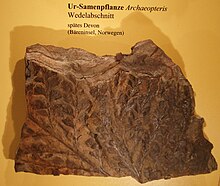Progymnosperm
| Progymnospermopsida Temporal range: Middle Devonian to Mississipian
| |
|---|---|

| |
| Archaeopteris fossil leaves | |
| Scientific classification | |
| Kingdom: | |
| Subkingdom: | |
| Class: | †Progymnospermopsida
|
| Orders | |
The progymnosperms were an extinct group of woody, spore-bearing plants that probably evolved from the "trimerophytes", and eventually gave rise to the gymnosperms.[1] They have been treated formally at the rank of division Progymnospermophyta or class Progymnospermopsida (as opposite). The stratigraphically oldest known examples belong to the Middle Devonian order the Aneurophytales, with forms such as Protopteridium, in which the vegetative organs consisted of relatively loose clusters of axes.[2] Tetraxylopteris is another example of a genus lacking leaves. In more advanced aneurophytaleans such as Aneurophyton these vegetative organs started to look rather more like fronds,[3], and eventually during Late Devonian times probably gave rise to the pteridosperm order the Lyginopteridales. In Late Devonian times, another group of progymnosperms gave rise to the first really large trees known as Archaeopteris.
Other characteristics:
- Vascular cambium with unlimited growth potential is present as well as xylem and phloem.
- Ancestors of the earliest seed plants as well as the first true trees.
- Strong monopodial growth is exhibited.
- Some were heterosporous but others were homosporous.
References
- ^ Stewart, W.N.; Rothwell, G.W. (1993). Paleobiology and the evolution of plants. Cambridge University Press. p. 521pp.
{{cite book}}: CS1 maint: multiple names: authors list (link) - ^ Lang, W. H. (1925). "Contributions to the study of the Old Red Sandstone flora of Scotland. I. On plant-remains from the fish-beds of Cromarty. II. On a sporangium-bearing branch-system from the Stromness Beds." Transactions of the Royal Society of Edinburgh, 54: 253-279.
- ^ Serlin, B. S. & Banks, H. P. (1978). "Morphology and anatomy of Aneurophyton, a progymnosperm from the Late Devonian of New York. Palaeontographica Americana, 8: 343-359.
